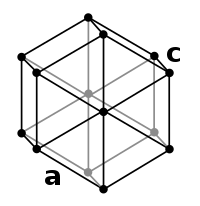
Photo from wikipedia
Nowadays, vacuum-ultraviolet (VUV) photodetectors (PDs) have attracted extensive attention owing to their potential applications in space exploration, radiation monitoring, and the semiconductor industry. Benefiting from its intrinsic ultra-wide band-gap, chemical… Click to show full abstract
Nowadays, vacuum-ultraviolet (VUV) photodetectors (PDs) have attracted extensive attention owing to their potential applications in space exploration, radiation monitoring, and the semiconductor industry. Benefiting from its intrinsic ultra-wide band-gap, chemical robustness, and low-cost features, LaAlO3 shows great promise in developing next-generation compact, cheap, and easy-to-fabricate VUV PDs. In this work, we report the unique anisotropic photoresponse behavior of LaAlO3 single crystals for VUV photodetection applications. First of all, with the guidance of density functional theory (DFT) calculations along with the comprehensive material characterization, the anisotropic carrier transport behavior of LaAlO3 single crystals was confirmed. Thereafter, after exploring the metal-semiconductor-metal (MSM) device configuration along different substrate orientations, including (100), (110), and (111)-LaAlO3 single crystals, we found that the (110)-LaAlO3 VUV PD exhibits the best device performance under VUV illumination, with a responsivity of 2.23 mA W-1, a high detectivity of 3.72 × 1011 Jones, and a photo-to-dark-current ratio of 5.48 × 103. This work not only provides a feasible avenue to explore the anisotropic optoelectronic behavior of ultra-wide band-gap semiconductors but also expands the application of the low-cost oxide perovskite family in the field of VUV photodetection.
Journal Title: Nanoscale
Year Published: 2022
Link to full text (if available)
Share on Social Media: Sign Up to like & get
recommendations!